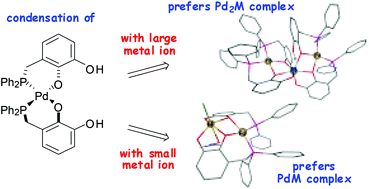Heterobimetallic catechol-phosphine complexes with palladium and a group-13 element: structural flexibility and dynamics†
Abstract
Group-13 metal acetylacetonates [M(acac)3] (M = Al, Ga, In) or Al(OiPr)3 react with a complex [Pd(catphosH)2] that may act as chelating ligand towards a second metal, or with a mixture of catechol phosphine (catphosH2) and [PdCl2(cod)], to give heterometallic complexes featuring either dinuclear M(catphos)2Pd or trinuclear M{(catphos)2Pd}2 motifs. Characterisation of the products by crystallographic and solution NMR studies gives insight into the structural diversity and flexibility of the coordination environments of the group-13 elements and their impact on the stability of the multinuclear complexes. The results indicate that gallium and indium are the most suitable elements for the stabilisation of di- and trinuclear assemblies, respectively. Dynamic NMR spectroscopy allowed to follow the dynamic averaging of the coordination environments of the four distinguishable catechol phosphines in the indium complex [M{(catphos)2Pd}2]H. The results revealed that the isomerisation follows a complicated pathway involving several distinguishable proton transfer steps, and allowed to propose a mechanistic explanation for the observed isomerisation.


 Please wait while we load your content...
Please wait while we load your content...